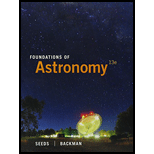
Identify the object in the solar system.
Answer to Problem 1RQ
The object described here is a meteoroid.
Explanation of Solution
A meteoroid is nothing but is a piece of stone debris move through the space. This may have found in large or smaller size. Some of the smallest meteoroid comes from the moon or mars and largest meteoroid assumed to be comes from the asteroid belt. Meteoroids also will come to the earth’s atmosphere and it will start to glow because of the attrition.
Meteoroids can also make big impact on the planets as well as different moon surfaces. Most of the meteoroids are larger than a pebble and are rocky. These are also the part of Solar system. When these are enter into the earth’s atmosphere and some part is survived form the friction, the leftover part is known as meteorite.
Conclusion:
Therefore, the object described here is a meteoroid.
Want to see more full solutions like this?
Chapter 25 Solutions
Foundations Of Astronomy, Loose-leaf Version
- Since 1995, hundreds of extrasolar planets have been discovered. There is the exciting possibility that there is life on one or more of these planets. To support life similar to that on the Earth, the planet must have liquid water. For an Earth-like planet orbiting a star like the Sun, this requirement means that the planet must be within a habitable zone of 0.9 AU to 1.4 AU from the star. The semimajor axis of an extrasolar planet is inferred from its period. What range in periods corresponds to the habitable zone for an Earth-like Planet orbiting a Sun-like star?arrow_forwardEstimate the maximum height of the mountains on a hypothetical planet similar to Earth but with twice the surface gravity of our planet.arrow_forwardToday at the beach you see the highest of all high tides during the last month. You see the Moon in the daytime sky. What is the most likely Moon phase? Why?arrow_forward
- Must engineers take Earth’s rotation into account when constructing very tall buildings at any location other than the equator or very near the poles?arrow_forwardThe total mass of this planet's atmosphere may be higher than the Earth's but the gases present must be very lighter ones like hydrogen and helium. The escape velocity of the planet will be very high. Due to the high escape velocity the light gases were not able to escape and hence forming a thick atmosphere Is the escaping velocity for this planet greater or lower than that of the earth?arrow_forward


 Foundations of Astronomy (MindTap Course List)PhysicsISBN:9781337399920Author:Michael A. Seeds, Dana BackmanPublisher:Cengage Learning
Foundations of Astronomy (MindTap Course List)PhysicsISBN:9781337399920Author:Michael A. Seeds, Dana BackmanPublisher:Cengage Learning Stars and Galaxies (MindTap Course List)PhysicsISBN:9781337399944Author:Michael A. SeedsPublisher:Cengage Learning
Stars and Galaxies (MindTap Course List)PhysicsISBN:9781337399944Author:Michael A. SeedsPublisher:Cengage Learning University Physics Volume 1PhysicsISBN:9781938168277Author:William Moebs, Samuel J. Ling, Jeff SannyPublisher:OpenStax - Rice University
University Physics Volume 1PhysicsISBN:9781938168277Author:William Moebs, Samuel J. Ling, Jeff SannyPublisher:OpenStax - Rice University An Introduction to Physical SciencePhysicsISBN:9781305079137Author:James Shipman, Jerry D. Wilson, Charles A. Higgins, Omar TorresPublisher:Cengage Learning
An Introduction to Physical SciencePhysicsISBN:9781305079137Author:James Shipman, Jerry D. Wilson, Charles A. Higgins, Omar TorresPublisher:Cengage Learning





